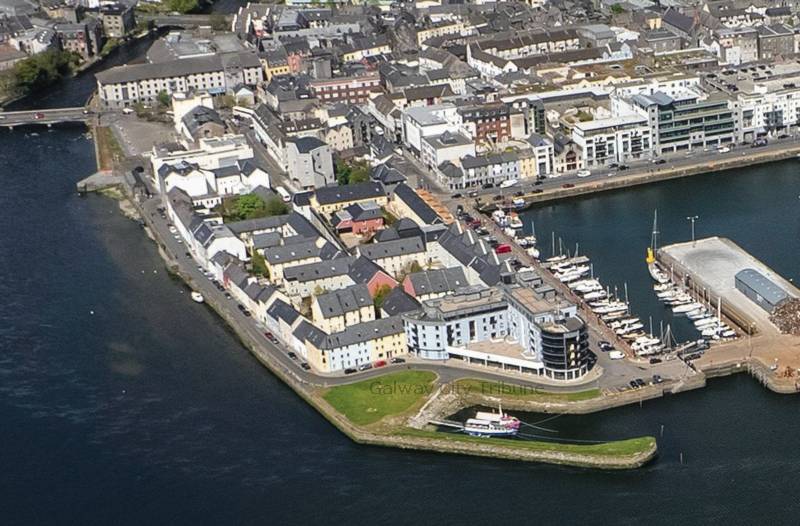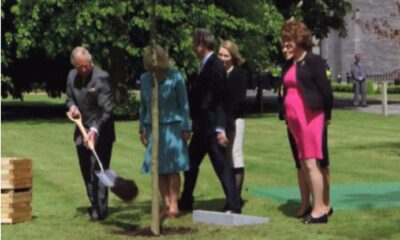CITY TRIBUNE
New Volvo C40 Recharge is a lot like the award-winning XC40 SUV

Take the electric element away from any review of the Volvo C40 and we are left with a basic car that we can measure from a practical every-day use. We’ll get back to the motor later, but first let’s talk about the Volvo C40 Recharge and why it is worth a second look for anyone in the market for a new good-looking car.
Volvo, now owned by Chinese company Geely, has been producing some of the safest cars around for many years. Chinese ownership has not diluted any of the safety features whatsoever. This trend continues in the C40, which comes in two levels – Plus and Ultimate – and will attract many buyers for this reason alone.
This is based on Volvo’s XC40 – their award-winning SUV – but comes with a sloping roof line in an attempt to attract buyers with the new profile, and it is more or less a success. The C40 does look good from every angle and the lights design and 192 wheels adding some class to the overall looks.
Inside, the car is a lot like the XC40. This car is a full electric crossback with a beautiful leather-clad interior and a high level of technology, including Google connectivity. Thankfully Volvo have reduced their dependence on the touch screen and applied more manual switchgear than in some previous models.
While spending time in the car, there were some blips in the technology system, and while I assume that these were a once-off problem with my particular car, it highlights the need to have basic controls on the dash and not all in a screen.
And, while I’m at it, the other quibble is that the visibility through the rear window is seriously restricted. The slope on the back window, added to by the size of the three rear bulky headrests, makes reversing and parking difficult, and the general rear vista compromised.
There is another real difference between the two: the C40 is only available in electric mode, whereas the XC40 is also available with petrol power. The electric combination of a single motor and 69kWh lithium-ion battery gives you one of the fastest EVs around and promises a range of 432kw on a full charge.
As we know by now, this figure is impossible to achieve in the real world. This is the same with all electric vehicles, with most achieving between 65 and 70% of the range suggested. Here the average return was around 350km per full charge. Volvo tells us that the car can be charged at a fast charger from 10% to 80% in 27 minutes.
An interesting feature of the C40 is the keyless entry and start system. Many cars come with keyless entry, but this car has a start system that only needs to have the key onboard to allow you drive away – there is no start button. Is it necessary or even useful? Probably not!
On the road, the C40 is really quick with 408hp and a zero to 100km time of just 4.7 seconds. Handling is good for a car that weighs 2045kg. The low centre of gravity because the batteries are spread around the floor adds to the stability on all sorts of surfaces.
Buyers choosing the C40 over the XC40 will enjoy a handsome car that has the looks and a superb interior, including a rather brilliant Harman Kardon surround sound audio system with 12 speakers and subwoofer. The Volvo C40 may not be quite as practical as the XC40 but it is a really nice car.
CITY TRIBUNE
Galway ‘masterplan’ needed to tackle housing and transport crises

From the Galway City Tribune – An impassioned plea for a ‘masterplan’ that would guide Galway City into the future has been made in the Dáil. Galway West TD Catherine Connolly stated this week that there needed to be an all-inclusive approach with “vision and leadership” in order to build a sustainable city.
Deputy Connolly spoke at length at the crisis surrounding traffic and housing in Galway city and said that not all of the blame could be laid at the door of the local authority.
She said that her preference would be the provision of light rail as the main form of public transport, but that this would have to be driven by the government.
“I sat on the local council for 17 years and despaired at all of the solutions going down one road, metaphorically and literally. In 2005 we put Park & Ride into the development plan, but that has not been rolled out. A 2016 transport strategy was outdated at the time and still has not been updated.
“Due to the housing crisis in the city, a task force was set up in 2019. Not a single report or analysis has been published on the cause of the crisis,” added Deputy Connolly.
She then referred to a report from the Land Development Agency (LDA) that identified lands suitable for the provision of housing. But she said that two-thirds of these had significant problems and a large portion was in Merlin Park University Hospital which, she said, would never have housing built on it.
In response, Minister Simon Harris spoke of the continuing job investment in the city and also in higher education, which is his portfolio.
But turning his attention to traffic congestion, he accepted that there were “real issues” when it came to transport, mobility and accessibility around Galway.
“We share the view that we need a Park & Ride facility and I understand there are also Bus Connects plans.
“I also suggest that the City Council reflect on her comments. I am proud to be in a Government that is providing unparalleled levels of investment to local authorities and unparalleled opportunities for local authorities to draw down,” he said.
Then Minister Harris referred to the controversial Galway City Outer Ring Road which he said was “struck down by An Bord Pleanála”, despite a lot of energy having been put into that project.
However, Deputy Connolly picked up on this and pointed out that An Bord Pleanála did not say ‘No’ to the ring road.
“The High Court said ‘No’ to the ring road because An Bord Pleanála acknowledged it failed utterly to consider climate change and our climate change obligations.
“That tells us something about An Bord Pleanála and the management that submitted such a plan.”
In the end, Minister Harris agreed that there needed to be a masterplan for Galway City.
“I suggest it is for the local authority to come up with a vision and then work with the Government to try to fund and implement that.”
CITY TRIBUNE
Official opening of Galway’s new pedestrian and cycle bridge

The new Salmon Weir pedestrian and cycle bridge will be officially opened to the public next Friday, May 26.
Work on the €10 million bridge got underway in April 2022, before the main structure was hoisted into place in early December.
A lunchtime tape-cutting ceremony will take place on Friday, as the first pedestrians and cyclists traverse the as-yet-unnamed bridge.
The Chief Executive of Galway City Council, Brendan McGrath, previously said the bridge, once opened, would remove existing conflicts between pedestrians, cyclists and traffic “as well as facilitating the Cross-City Link public transport corridor over the existing 200-year-old bridge”.
The naming of the new bridge has been under discussion by the Council’s Civic Commemorations Committee since late last year.
One name that has been in the mix for some time is that of the first woman in Europe to graduate with an engineering degree – Alice Perry.
Ms Perry, who was from Wellpark, graduated from Queen’s College Galway (now University of Galway) in 1906. The university’s engineering building is named in her honour.
The bridge was built by Jons Civil Engineering firm in County Meath and was assembled off-site before being transported to Galway. Funding for the project was provided in full by the National Transport Authority and the European Regional Development Fund.
(Photo: Sheila Gallagher captured the city’s new pedestrian footbridge being raised on the south side of the Salmon Weir Bridge in December. It will officially open next Friday, May 26).
CITY TRIBUNE
Minister branded ‘a disgrace’ for reversing land rezoning in Galway City

From the Galway City Tribune – Minister of State for Local Government and Planning, Kieran O’Donnell was labelled a “disgrace” for overturning councillors’ decisions to rezone land in the new City Development Plan.
Minister O’Donnell (pictured) confirmed in a letter to Council Chief Executive Brendan McGrath last week that he was reversing 25 material alternations made by councillors to the CDP 2023-29. He made the decision on the advice of Office of Planning Regulator (OPR).
Minister O’Donnell directed that 14 land parcels that were subject to land-use zoning changes by councillors as part of the Material Alterations to the Draft CDP should be reversed.
He directed that a further 11 land parcels in the city should become “unzoned”.
The Minister found that the CDP had not been made in a manner consistent with recommendations of the OPR, which required specific changes to the plan to ensure consistency with the national planning laws and guidelines.
At last week’s Council meeting Cllr Eddie Hoare (FG) asked for clarity on the process by which councillors could rezone the lands that had been changed by the Minister’s direction.
Cllr Declan McDonnell said, “What he [Minister O’Donnell] has done is an absolute disgrace”.
And he asked: “Do we have to have another development plan meeting to deal with it?”
Both Cllrs Hoare and McDonnell wondered what would become of the lands that were rezoned or unzoned by the ministerial direction.
Mr McGrath said the Council had put forward an argument in favour of retaining the material alterations in the plan, but ultimately the Minister sided with OPR.
He said if councillors want to make alterations to the new plan, they could go through the process of making a material alteration but this was lengthy.
The Save Roscam Peninsula campaign welcomed the Minister’s decision.
In a statement to the Galway City Tribune, it said the direction would mean the Roscam village area on the Roscam Peninsula will be unzoned and a number of land parcels would revert back to agriculture/high amenity.
A spokesperson for the campaign said: “the material alterations made by city councillors following lobbying by developers continued the long-standing practice of councillors facilitating a developer-led plan rather than an evidence- and policy-based plan that meets the needs of the city.
“The Minister’s direction is an important step in restoring confidence in the planning system. It is clear from the City Council’s own evidence on future housing projections that there was no requirement to zone these lands for residential purposes in order to meet the needs of the targeted population increase up to 2029,” the spokesperson added.















